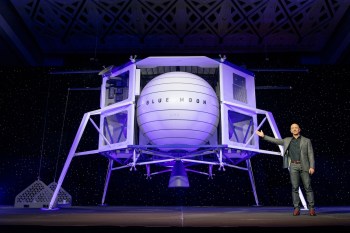How big a stimulus is a stealth bomber contract?
The defense contractor Northrop Grumman just won a whale of a Pentagon contract — to produce the next-generation long-range, radar-evading bomber. Pricetag: half a billion dollars per plane.
Northrop Grumman hasn’t announced where it will build the bomber. But already, people around the company’s assembly plant in Palmdale in Southern California’s Antelope Valley are celebrating.
“You think about the old stealth bombers — those were built up there in the Skunk Works,” said economist Christopher Thornberg of the research and consulting firm Beacon Economics. “There’s a couple big testing ranges that still operate up there, including China Lake. So defense and the Antelope Valley have always gone hand in hand.”
There’s speculation the valley may get 1,100 well-paid aerospace jobs from the Northrop contract. But for perspective, Southern California has nearly 100,000 of those jobs already. And the region’s defense industry is just one-third of its size during the Cold War.
And today’s defense contracts don’t always produce jobs the way they used to.
“The components that go into an aircraft today are increasingly electronic,” said economist Robert Kleinhenz of the Los Angeles County Economic Development Corporation. “So you have less of a need for mechanical assemblies that might have required more human hands, if you will.”
Given the secretive mission of this warplane and its technology, it will largely be made in America. Northrop will assemble the aircraft, but won’t make all the parts. Its key suppliers stretch across the country, so the contract’s economic stimulus effect will be spread out.
“There is only a small number of companies that can actually produce the advanced subsystems,” said Kenneth Mayer, political scientist at the University of Wisconsin-Madison and author of “The Political Economy of Defense Contracting.”
“You have probably two companies, General Electric and Pratt & Whitney, who can produce the engines,” Mayer said. “You have a small number of companies that can produce the advanced avionics.”
There will be winners, as in years past. This is the largest military aircraft contract in more than a decade.
Local officials seeking to attract large corporate deals like this sometimes call this “the buffalo hunt” and celebrate nabbing big game.
But Beacon Economics’s Thornberg offers this perspective:
“Buffalo hunt all you want. The reality is, the day-to-day stuff is more effective at keeping an economy going. Look, this is great news for the region, but let’s not overstate it.”
There’s a lot happening in the world. Through it all, Marketplace is here for you.
You rely on Marketplace to break down the world’s events and tell you how it affects you in a fact-based, approachable way. We rely on your financial support to keep making that possible.
Your donation today powers the independent journalism that you rely on. For just $5/month, you can help sustain Marketplace so we can keep reporting on the things that matter to you.


















